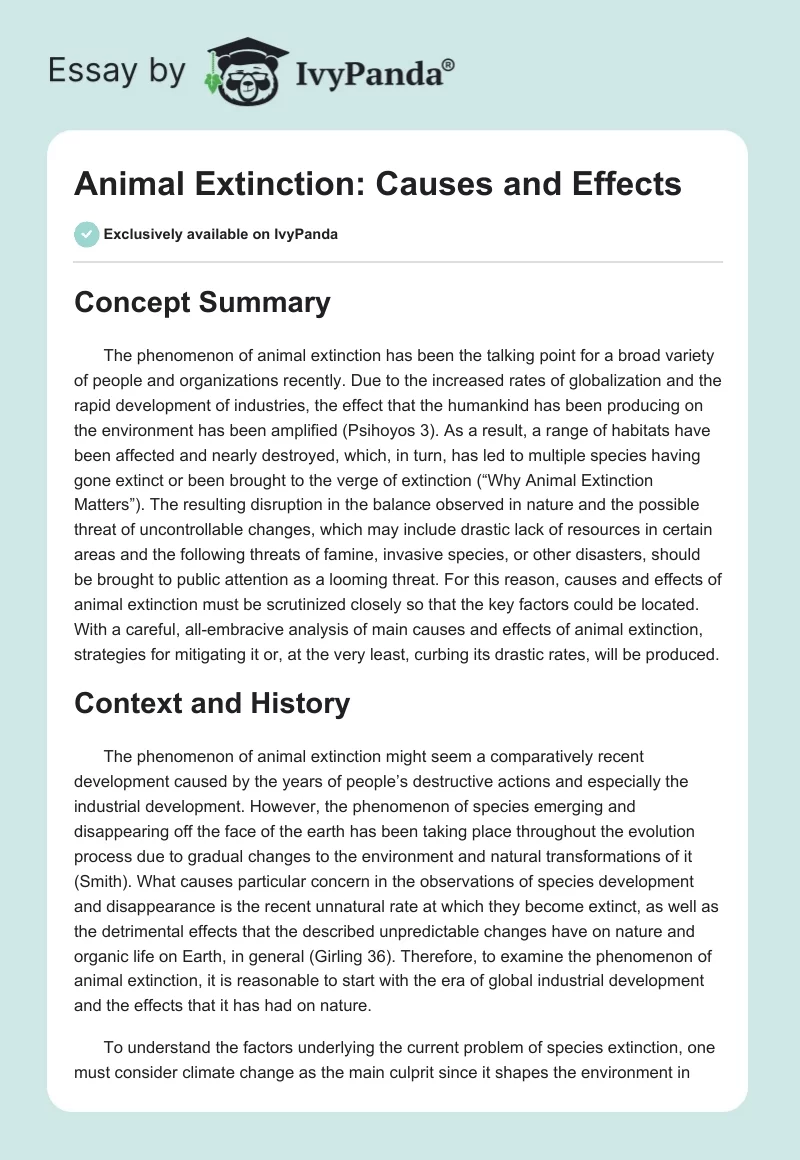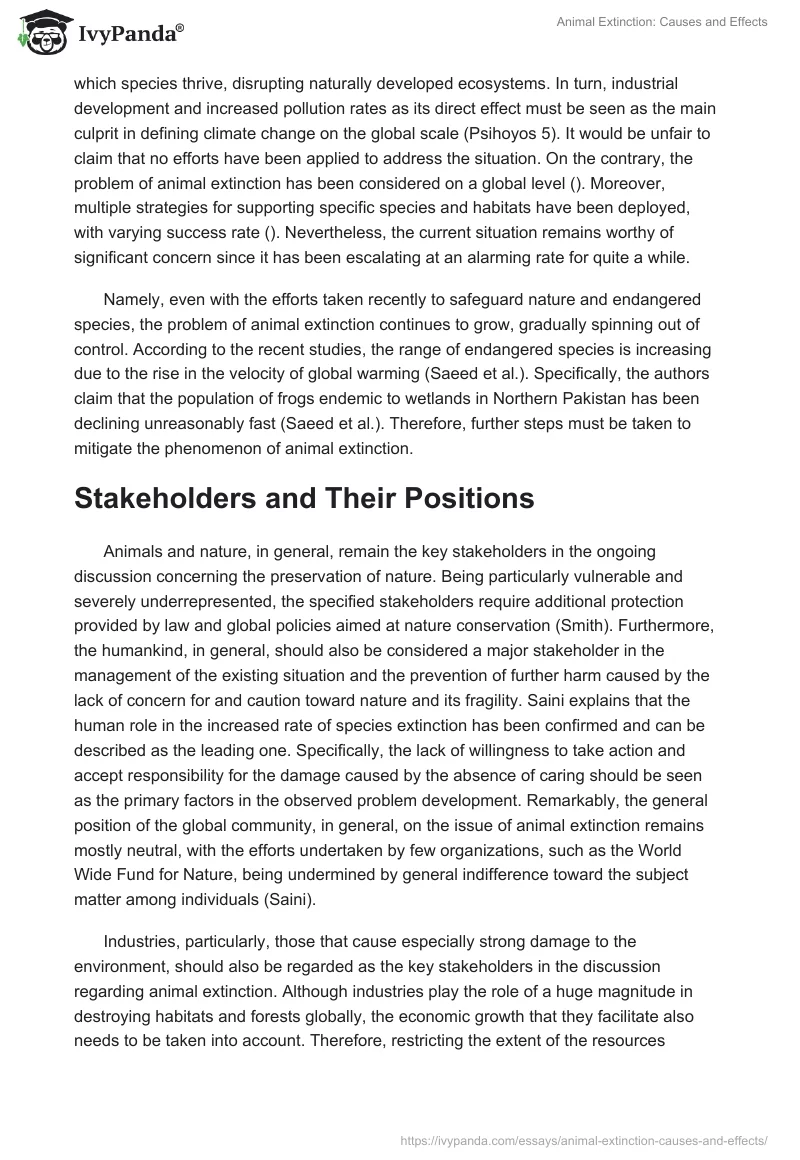Concept Summary
The phenomenon of animal extinction has been the talking point for a broad variety of people and organizations recently. Due to the increased rates of globalization and the rapid development of industries, the effect that the humankind has been producing on the environment has been amplified (Psihoyos 3). As a result, a range of habitats have been affected and nearly destroyed, which, in turn, has led to multiple species having gone extinct or been brought to the verge of extinction (“Why Animal Extinction Matters”).
The resulting disruption in the balance observed in nature and the possible threat of uncontrollable changes, which may include drastic lack of resources in certain areas and the following threats of famine, invasive species, or other disasters, should be brought to public attention as a looming threat. For this reason, causes and effects of animal extinction must be scrutinized closely so that the key factors could be located. With a careful, all-embracive analysis of main causes and effects of animal extinction, strategies for mitigating it or, at the very least, curbing its drastic rates, will be produced.
Context and History
The phenomenon of animal extinction might seem a comparatively recent development caused by the years of people’s destructive actions and especially the industrial development. However, the phenomenon of species emerging and disappearing off the face of the earth has been taking place throughout the evolution process due to gradual changes to the environment and natural transformations of it (Smith). What causes particular concern in the observations of species development and disappearance is the recent unnatural rate at which they become extinct, as well as the detrimental effects that the described unpredictable changes have on nature and organic life on Earth, in general (Girling 36). Therefore, to examine the phenomenon of animal extinction, it is reasonable to start with the era of global industrial development and the effects that it has had on nature.
To understand the factors underlying the current problem of species extinction, one must consider climate change as the main culprit since it shapes the environment in which species thrive, disrupting naturally developed ecosystems. In turn, industrial development and increased pollution rates as its direct effect must be seen as the main culprit in defining climate change on the global scale (Psihoyos 5). It would be unfair to claim that no efforts have been applied to address the situation. On the contrary, the problem of animal extinction has been considered on a global level (). Moreover, multiple strategies for supporting specific species and habitats have been deployed, with varying success rate (). Nevertheless, the current situation remains worthy of significant concern since it has been escalating at an alarming rate for quite a while.
Namely, even with the efforts taken recently to safeguard nature and endangered species, the problem of animal extinction continues to grow, gradually spinning out of control. According to the recent studies, the range of endangered species is increasing due to the rise in the velocity of global warming (Saeed et al.). Specifically, the authors claim that the population of frogs endemic to wetlands in Northern Pakistan has been declining unreasonably fast (Saeed et al.). Therefore, further steps must be taken to mitigate the phenomenon of animal extinction.
Stakeholders and Their Positions
Animals and nature, in general, remain the key stakeholders in the ongoing discussion concerning the preservation of nature. Being particularly vulnerable and severely underrepresented, the specified stakeholders require additional protection provided by law and global policies aimed at nature conservation (Smith). Furthermore, the humankind, in general, should also be considered a major stakeholder in the management of the existing situation and the prevention of further harm caused by the lack of concern for and caution toward nature and its fragility. Saini explains that the human role in the increased rate of species extinction has been confirmed and can be described as the leading one. Specifically, the lack of willingness to take action and accept responsibility for the damage caused by the absence of caring should be seen as the primary factors in the observed problem development. Remarkably, the general position of the global community, in general, on the issue of animal extinction remains mostly neutral, with the efforts undertaken by few organizations, such as the World Wide Fund for Nature, being undermined by general indifference toward the subject matter among individuals (Saini).
Industries, particularly, those that cause especially strong damage to the environment, should also be regarded as the key stakeholders in the discussion regarding animal extinction. Although industries play the role of a huge magnitude in destroying habitats and forests globally, the economic growth that they facilitate also needs to be taken into account. Therefore, restricting the extent of the resources available to manufacturers will lead to a rapid economic decline, which is also an undesirable outcome.
Finally, non-governmental organizations (NGOs) and charities aimed at supporting nature and preventing its destruction must be seen as important stakeholders in the argument concerning animal extinction. Investing into animal protection, these organizations provide the resources for curbing the rates of animal extinction and ecosystems destruction. Thus, they represent an important side in the argument under analysis.
Thesis and Possible Arguments
In order to curb the current rates of animal extinction, the present capitalist approach toward, managing human-animal relations and the use of natural resources must be scrutinized and deconstructed with the focus on sustainability and ethics. Particularly, the need to view animals as living beings equally deserving sympathy must be promoted as one of the foundational steps toward improving the current situation (Stuart and Gunderson 71). In turn, the issue of defaunation, which has been observed continuously for a significant time span as a result of the increased fast food production and the resulting rise in the range of green areas used as pasture fields, also must be addressed promptly. Galetti et al. suggests that the shift toward lesser consumerism rates and the reduced production rates should occur as the means of minimizing the amount of wasted food and resources (318).
Embracing the existing alternatives concerning the management of global environmental changes without impairing the present economic growth, one should consider the opportunities associated with transitioning to a new mode of production. Stewart and Gunderson (2018) emphasize the necessity to transition from the capital ethos that is actively promoted in the current global capitaloscene to the human-animal relations based on the principles of sustainability. Thus, the instrumentalization of animals and the perspective that allows viewing them purely as commodities will be minimized (Stewart & Gunderson, 2018). Thus, a new ethos for approaching human-animal relations, which is rooted in sympathy and appreciation for animals’ lives, should be interpreted as one of the main alternatives to the current capitalist framework of perceiving animas and other natural resources.
Works Cited
Galetti, Mauro, et al. “Causes and Consequences of Large-Scale Defaunation in the Atlantic Forest.” The Atlantic Forest. Springer, Cham, 2021. 297-324.
Girling, Richard. “Whales in Peril: Deep Impact.” The Times, 2010, Web.
Psihoyos, Louie. Racing Extinction. Abramorama, 2015.
Saeed, Muhammad, et al. “Rise in Temperature Causes Decreased Fitness and Higher Extinction Risks in Endemic Frogs at High Altitude Forested Wetlands in Northern Pakistan.” Journal of Thermal Biology, vol. 2021. Web.
Saini, Divya. “Animal Extinction and Ways of Preventing the Human Role in it.” International Journal of Multidisciplinary Research Review, vol. 3, no. 10. Web.
Smith, Fraser D. M., et al. “How Much Do We Know About the Current Extinction Rate?” Trends in Ecology & Evolution, Elsevier Current Trends, 13 Nov. 2003, Web.
Stuart, Diana, and Ryan Gunderson. “Human-Animal Relations in the Capitalocene: Environmental Impacts and Alternatives.” Environmental Sociology, vol. 6, no. 1, 2020, pp. 68-81.
“Why Animal Extinction Matters.” Washington Post, 2017. Web.


